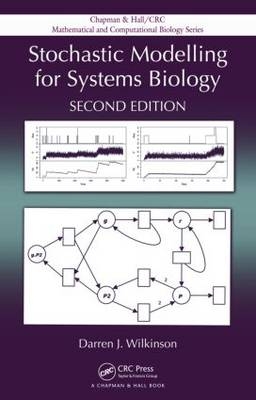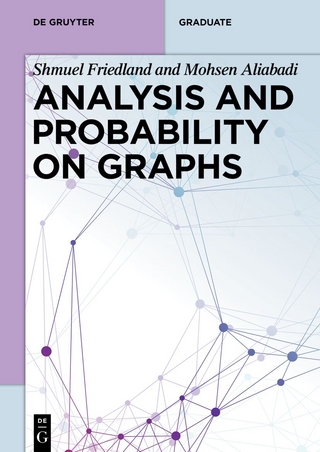
Stochastic Modelling for Systems Biology
Crc Press Inc (Verlag)
978-1-4398-3772-6 (ISBN)
- Titel erscheint in neuer Auflage
- Artikel merken
Keeping with the spirit of the first edition, all of the new theory is presented in a very informal and intuitive manner, keeping the text as accessible as possible to the widest possible readership.
New in the Second Edition
All examples have been updated to Systems Biology Markup Language Level 3
All code relating to simulation, analysis, and inference for stochastic kinetic models has been re-written and re-structured in a more modular way
An ancillary website provides links, resources, errata, and up-to-date information on installation and use of the associated R package
More background material on the theory of Markov processes and stochastic differential equations, providing more substance for mathematically inclined readers
Discussion of some of the more advanced concepts relating to stochastic kinetic models, such as random time change representations, Kolmogorov equations, Fokker-Planck equations and the linear noise approximation
Simple modelling of "extrinsic" and "intrinsic" noise
An effective introduction to the area of stochastic modelling in computational systems biology, this new edition adds additional mathematical detail and computational methods that will provide a stronger foundation for the development of more advanced courses in stochastic biological modelling.
Darren Wilkinson is Professor of Stochastic Modelling at Newcastle University in the UK. He was educated at the nearby University of Durham, where he took his first degree in Mathematics, followed by a Ph.D. in Bayesian statistics which he completed in 1995. He moved to a lectureship in statistics at the Newcastle University in 1996, where he has remained since, being promoted to his current post in 2007. Professor Wilkinson is interested in computational statistics and Bayesian inference and in the application of modern statistical technology to problems in statistical bioinformatics and systems biology. He is involved in a variety of systems biology projects at Newcastle, including the Centre for Integrated Systems Biology of Ageing and Nutrition (CISBAN). He recently held a BBSRC Research Development Fellowship on Integrative modelling of stochasticity, noise, heterogeneity and measurement error in the study of model biological systems.
Modelling and Networks
Introduction to Biological Modelling
What is modelling?
Aims of modelling
Why is stochastic modelling necessary?
Chemical reactions
Modelling genetic and biochemical networks
Modelling higher-level systems
Representation of Biochemical Networks
Coupled chemical reactions
Graphical representations
Petri nets
Stochastic process algebras
Systems Biology Markup Language (SBML)
SBML-shorthand
Stochastic Processes and Simulation
Probability Models
Probability
Discrete probability models
The discrete uniform distribution
The binomial distribution
The geometric distribution
The Poisson distribution
Continuous probability models
The uniform distribution
The exponential distribution
The normal/Gaussian distribution
The gamma distribution
Quantifying "noise"
Stochastic Simulation
Introduction
Monte Carlo integration
Uniform random number generation
Transformation methods
Lookup methods
Rejection samplers
Importance resampling
The Poisson process
Using the statistical programming language, R
Analysis of simulation output
Markov Processes
Introduction
Finite discrete time Markov chains
Markov chains with continuous state-space
Markov chains in continuous time
Diffusion processes
Stochastic Chemical Kinetics
Chemical and Biochemical Kinetics
Classical continuous deterministic chemical kinetics
Molecular approach to kinetics
Mass-action stochastic kinetics
The Gillespie algorithm
Stochastic Petri nets (SPNs)
Structuring stochastic simulation codes
Rate constant conversion
Kolmogorov’s equations and other analytic representations
Software for simulating stochastic kinetic networks
Case Studies
Introduction
Dimerisation kinetics
Michaelis–Menten enzyme kinetics
An auto-regulatory genetic network
The lac operon
Beyond the Gillespie Algorithm
Introduction
Exact simulation methods
Approximate simulation strategies
Hybrid simulation strategies
Bayesian Inference
Bayesian Inference and MCMC
Likelihood and Bayesian inference
The Gibbs sampler
The Metropolis–Hastings algorithm
Hybrid MCMC schemes
Metropolis–Hastings algorithms for Bayesian inference
Bayesian inference for latent variable models
Alternatives to MCMC
Inference for Stochastic Kinetic Models
Introduction
Inference given complete data
Discrete-time observations of the system state
Diffusion approximations for inference
Likelihood-free methods
Network inference and model comparison
Conclusions
SBML Models
Auto-regulatory network
Lotka–Volterra reaction system
Dimerisation-kinetics model
References
Index
All chapters include exercises and further reading.
| Reihe/Serie | Chapman & Hall/CRC Mathematical and Computational Biology |
|---|---|
| Zusatzinfo | 2 Tables, black and white; 84 Illustrations, black and white |
| Verlagsort | Bosa Roca |
| Sprache | englisch |
| Maße | 156 x 235 mm |
| Gewicht | 658 g |
| Themenwelt | Mathematik / Informatik ► Mathematik ► Wahrscheinlichkeit / Kombinatorik |
| Naturwissenschaften ► Biologie | |
| Technik ► Umwelttechnik / Biotechnologie | |
| ISBN-10 | 1-4398-3772-4 / 1439837724 |
| ISBN-13 | 978-1-4398-3772-6 / 9781439837726 |
| Zustand | Neuware |
| Informationen gemäß Produktsicherheitsverordnung (GPSR) | |
| Haben Sie eine Frage zum Produkt? |
aus dem Bereich



